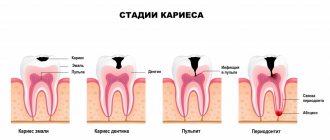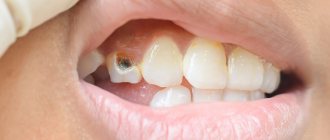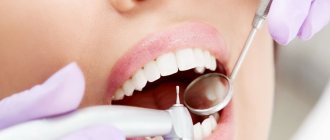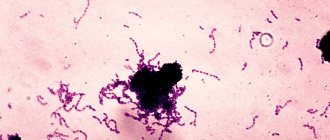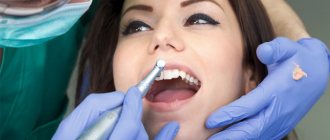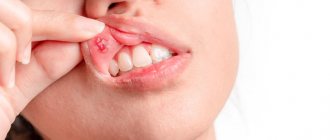- home
- Diseases
- Caries
- Deep caries
Deep caries is the fourth and final stage of destruction and demineralization of hard tooth tissues. Looking at the photo of deep caries, you can immediately notice the presence of a carious hollow. From the outside it may seem small, but inside there is always significant destruction of dental tissue.
With deep caries, the carious cavity is separated from the pulp by only a narrow layer of dentin, which with further development of the disease can lead to the development of pulpitis, periodontitis or periostitis. Thus, the main task of the dentist is to preserve all the functions of the tooth and minimize the risk of developing these diseases.
Etiology
The medical history of deep caries may indicate the primary or secondary development of the disease. In the first case, it occurs due to the lack of professional treatment of the middle stage of caries, in the second - after tooth preparation (incorrect treatment, chipped filling). Otherwise, the factors stimulating the development of the disease are the same as for caries in general: poor hygiene, lack of necessary cleaning of hard-to-reach places, disturbances in pH levels, saliva composition, genetic predisposition.
In our clinic you can get a free dental consultation!
Classification
There are several types of caries for adults and children. The latter are worth mentioning separately, since the treatment of caries in children and adults is different. Varieties found in adults include:
- Fissure caries.
A disease characterized by the fact that fissures are affected - special grooves present on the surface of the teeth. Cavities form in the interdental spaces and natural recesses, which is associated with the accumulation of food debris in these places, which are extremely difficult to remove. - Cervical caries
, which affects the area around the neck of the tooth, characterized by a thin layer of enamel. This disease is sometimes called hidden caries because it is difficult to notice. - Atypical caries
is rare. This disease got its name due to the fact that it is not the most typical places that are affected - the cutting edge or the tubercle.
Secondary caries, the development of which is a consequence of improper work by the dentist, or the use of low-quality materials. This type of caries develops under installed fillings, crowns and dentures, and is often completely invisible.
Our doctors
18 years of experience
Baghdasaryan
Armen Evgenievich
Chief physician, dentist-orthopedist-therapist
Graduated from VSMA named after. N.N. Burdenko. Internship on the basis of MGMSU named after. A.E. Evdokimov in “General Dentistry”.
Clinical residency at the Moscow State Medical University named after. A.E. Evdokimov in “Orthopedics”.
More about the doctor...
5 years experience
Sadina
Ekaterina Vladislavovna
Dental therapist, surgeon
Penza State University Medical Institute, specialty “Dentistry”.
In 2016, she underwent professional retraining in the specialty “Therapeutic Dentistry” at the Moscow State Medical and Dental University named after A.I. Evdokimov.
More about the doctor...
8 years of experience
Arzumanov
Andranik Arkadievich
Dentist-orthodontist
Graduated from Moscow State Medical University. Internship - Moscow State Medical University at the Department of Orthodontics and Children's Prosthetics.
Residency at Moscow State Medical University at the Department of Orthodontics and Children's Prosthetics. Member of the Professional Society of Orthodontists of Russia since 2010.
More about the doctor...
Clinical manifestations
Symptoms of deep caries, first of all, consist of a sharp toothache when exposed to thermal, chemical or mechanical stimuli. The pain is short-term and disappears after the stimulus is removed. If pieces of food remain in the cavity, the pain becomes aching and can last until the irritants are eliminated. If the carious cavity is extensive, the patient may develop an unpleasant putrid odor from the mouth. Caries under a filling can develop for years and is characterized by the absence of clinical manifestations. Painful sensations occur only when the dentin is destroyed to the bottom of the tooth.
Acute deep caries
Like many other diseases, deep caries can occur in acute and chronic forms. The acute form is characterized by rapid development with pronounced decompensation. The dynamics of destructive processes in acute caries significantly exceed the compensatory capabilities of the body and the rate of restoration of affected tissues. As a result, the patient rapidly develops significant and deep damage to the dental tissues.
One of the most characteristic features of acute caries is the presence of sharp, severe pain. It can appear independently or as a reaction to temperature exposure (hot and cold liquids, food), mechanical stimuli (biting, pressure, friction), caustic environments (acids, salty, sweet). Even after stopping contact with the irritant, pain often persists for some time.
A dental examination reveals the presence of a deep, extensive cavity, often with a narrow entrance and a wide base. On its walls, deposits of decay products are often observed - white and loose. When pressing on the bottom of the cavity, sharp pain occurs.
Diagnostics
Deep caries is diagnosed during an examination by a dentist, who takes into account the patient’s complaints, examination results, thermal diagnostics and radiography data. Differential diagnosis of deep caries requires distinguishing it from the following diseases:
- periodontitis;
- pulpitis;
- average caries.
Treatment
Treatment of deep caries is carried out in several stages and sometimes requires two visits to the dentist. The latter is necessary if the dentist is not sure that the disease has not affected the pulp. In this case, the treatment plan includes the following:
- treatment of the carious cavity and removal of all affected tissues;
- applying an insulating pad;
- installation of a temporary filling;
- a second visit after three to four days and installation of a permanent filling if there is no pain.
If pain symptoms are present and increasing, pulpitis is treated.
How does caries occur?
In advertising, caries disease is portrayed as certain bacteria that settle on the surface of the tooth and destroy it. This looks like reality.
Pathogenic microorganisms that come from the outside or are contained in the natural microflora of a person begin to multiply in a favorable environment where all the conditions are created:
- change in acid-base balance;
- acceptable temperature;
- humid environment.
Let's add here the activation of carbohydrate fermentation processes after eating. All this leads to the production of large amounts of organic acids, which attack tooth enamel and cause caries.
The main circumstances that lead to the occurrence of carious lesions include:
- lack of hygiene;
- improper oral care;
- predominantly unbalanced diet;
- diseases of the gastrointestinal tract, both chronic and periods of exacerbation;
- decrease in the level of essential vitamins and microelements in the body;
- genetic predisposition
Hard plaque of bacteria
And if the problems listed above can be solved by adjusting nutrition and improving hygiene procedures, then you will have to fight the streptococcus bacillus.
The fact is that streptococcus is present in two states of aggregation: soft - in this case it will be easy to remove with a regular brush or dental floss, and hard.
The hard condition occurs due to an increase in the number of bacteria, their mineralization, resulting in the appearance of tartar, which cannot be removed at home.
Therefore, it is a good idea to undergo a hygienic professional cleaning procedure at a dental clinic to prevent caries.
A balanced diet is everything
You can use one rule - don't eat sweets. However, harmful carbohydrates, which lead to fermentation and the production of organic acids, are found not only in “delicious” foods. This includes any baked goods (including bread), added sugars (for example, in sauces and canned food), starchy foods (potatoes, carrots, tomatoes).
But this does not mean that you need to limit yourself in everything so that caries does not have a single chance. It is enough to add such foods to your diet in moderation; be sure to counterbalance them with whole grain cereals and green vegetables and fruits.
In addition, with age, the surface of the enamel becomes thinner and becomes more susceptible to what we eat every day.
Elemental composition of the body
A factor that is closely related to nutrition. If it is not balanced, most likely the body will not receive enough microelements necessary for the correct functioning of the body.
For example, calcium, phosphorus and fluoride are microelements that reduce the risk of dental caries. They are found in seeds, cottage cheese products, fatty cheese, canned red beans and some cereals.
Note! A diet enriched with microelements will not help if there is a genetic predisposition to demineralization, and “vitaminosis” can be observed during pregnancy - when the fetus “eats” the mother’s teeth, accumulating calcium, necessary for the proper development of the skeletal system. But this just means that in such cases you need to be even more responsible about your diet.
The work of the salivary glands
Water balance in the body has an interesting effect. It affects the full functioning of the salivary glands, which must secrete a sufficient amount of secretion to remove food debris and prevent the decomposition of bacteria.
Does your mouth often dry out? Try increasing the amount of water you consume, or analyze your diet - perhaps there is too much sweet or salty in your menu. Adjust this and let your saliva do its work.
Genetics and pathologies
Any disruptions in the body's natural metabolism - diabetes, gastrointestinal diseases (gastritis, ulcers) and hormonal imbalance - have an impact.
In these cases, even with a varied diet, beneficial components may not be absorbed well enough and vitamin starvation still occurs.
What are caries?
Diagnosis of caries involves dividing the disease depending on several factors: symptoms, source of occurrence, and so on. Let's consider the most understandable ones for the average patient without special medical education.
Areas of distribution
Everything is quite clear here:
- single - a carious cavity is localized on one tooth, begins with a harmless spot on the enamel, is not accompanied by pain until it goes deeper
- systemic (or multiple) - develops very quickly, affects several units in a row, has a depressing effect on the immune system.
According to the flow and emerging consequences:
- without complications - no special violations have been identified, dental intervention will not lead to a negative outcome;
- complicated - at the diagnostic stage, including studying an x-ray and opening the affected cavity, a violation of the internal tissues, pulpitis and periodontitis were revealed.
Stages of caries
This classification is most often found in the vocabulary of dentists, as it is used to describe the level of development of carious disease.
Let us arrange them in order of increasing complexity of treatment and the level of consequences of surgical intervention:
- darkening of the enamel or stain - accompanied by a change in the uniform color of the surface in the form of a small whitish or gray spot or stripe. At this stage, the patient does not experience pain, and if the pathology is invisible to the eye, the person himself will not notice it;
- initial superficial lesion - a small, almost imperceptible hole of a dark shade appears in place of the spot, which grows over time. The tooth reacts to temperature changes, drinking too hot or too cold drinks and foods;
- medium caries - the disease affects dentin - the part that is located directly under the enamel layer, so the pain is no longer periodic, but permanent, and the quality of life decreases;
- deep caries is a diagnosis that requires urgent intervention and treatment, as the pulp (nerve endings) is affected. Most likely, you will have to perform depulpation - in fact, depriving the tooth of nerve endings, which means that the tooth will be less protected from mechanical influences from the outside. Moreover, a tooth with advanced pulpitis must be removed and replaced with an implant or crown.
Separately, you can take out a type that differs in localization directly on the tooth. That is, the process usually begins from the affected edge of the tooth, or from the center.
However, if there is the presence of tartar, which in turn provokes bleeding gums, an increase in the colony of pathogenic bacteria and accelerated development of gingival lesions, then cervical caries occurs. It is located right next to the gums, where the most mineralized residues are found.
Diagnostic methods
Regardless of the severity of the pain, you should immediately consult a doctor at the first suspicion. You need to choose a dental clinic where they will conduct a full diagnosis and staging of the disease.
The main ways to determine the level of “neglect” of the oral cavity include:
- visual check - using a mirror and probe
Additional Information. Find out from the administrator or on available resources on the Internet whether the clinic uses microscopes in its work - a doctor with special microscope glasses will see more minute changes in the enamel than one who uses his own vision, no matter how sharp it is.
- digital images (this can be a regular X-ray, or a full-fledged computed tomography or popular 3D recognition);
- functional study;
- thermal testing
A high-quality diagnosis will give the doctor an understanding of how to treat caries in order to avoid the unpleasant results of untreated pathology, which affects the pulp under the filling and brings even more problems.
How to get rid of carious disease
The type of therapy directly depends on the stage of the disease.
In case of minor damage, conservative intervention is performed without preparation (drilling, cutting the gums or interfering with dentin and pulp):
- Visual diagnostics;
- Isolation of the tooth from the gingival fluid
- Gently cleans the surface from dark spots;
- Application of a mineralizing composition that will prevent re-injury, for example, with the Icon system
The mineralization composition will stop the spread of caries if all actions are performed accurately.
Traditional drill
If the pathology has turned into holes and with all subsequent deteriorations, they resort to the only method of treatment - mechanical exclusion of the affected areas using a drill or, simply, a drill.
This process is considered a surgical intervention and, if necessary and a low pain threshold, treatment of caries is carried out using anesthetics:
- Pain relief (if necessary, if the affected area is shallow, the patient may refuse the injection);
- Isolation of tooth with rubber dam.
- Mechanical cleaning of carious and softened tooth tissues - drilling;
- Application of medications to remove bacteria and prevent the formation of new caries;
- Complete repetition of the anatomical shape of the tooth;
- Polishing the filling.
If caries turns into pulpitis, this will complicate tooth treatment. Under anesthesia, it will be necessary to remove the nerve and seal the tooth canals with an inert substance. Otherwise, the inflammation will go further into the bone, into the jaw, into the blood, which can lead to very serious consequences, including tooth extraction and hospitalization.
Do not be afraid of the depulpation process. With enough attention and care, the tooth will function just like other teeth with nerves. The main thing is to cover such a tooth with a crown.
Caries in children
Dental problems are not limited to adults only. Kids are not yet used to or have not learned to pay enough attention to hygiene, and some really love sweets.All this leads to caries disease on temporary milk teeth. But do not take their temporary nature as a reason not to treat milk caries.
Damage to the milk row can lead to the same complications in the form of pulpitis and periodontitis, and you will have to resort to real general operating anesthesia to cure fidgety teeth.
In addition, deep caries can affect the formation of permanent dentition, so a preventive examination by a dentist is required for children once every six months.
Prevention is the key to health
This applies to both adults and children:
- maintain regular oral hygiene - brush your teeth twice a day with a toothpaste enriched with fluoride and calcium, use dental floss and brushes, mouth rinses, and if you cannot use a toothbrush, take chewing gum;
- Supplement your daily care with an appointment with a dental hygienist at least once a year to get rid of tartar;
- maintain a sleep schedule, diversify your diet, drink more water and engage in physical activity.
It is always easier to prevent a disease than to suffer from pain and then spend money and time on treatment in professional dentistry.
Where to treat?
You can undergo treatment for deep caries at the Good Hands dental clinic. Our specialists will make every effort to save the tooth and carry out its restoration, maintaining its appearance and functionality. It is very important to seek professional dental care in a timely manner in order to prevent the development of pulpitis and periodontitis, which can lead to tooth loss. Our specialists use effective anesthetics and modern equipment in their work. Thanks to this, the treatment will be comfortable and painless. Book a free consultation with us by filling out the simple form on this page or calling us!
Complications
Untimely treatment of caries leads to inevitable complications:
- development of pulpitis (the carious process gradually spreads to the deep layers of dentin surrounding the pulp of the tooth);
- if pulpitis is not treated, necrosis of the pulp occurs (i.e. it dies), as a result, a focus of inflammation appears at the apex of the tooth root;
- development of gum “flux” (a purulent process occurs between the jaw and periosteum);
- the appearance of a cyst at the apex of the tooth root (the bone tissue is resorbed, and inflammation forms in its place).
